2020 MERCEDES-BENZ SLC display
[x] Cancel search: displayPage 23 of 310
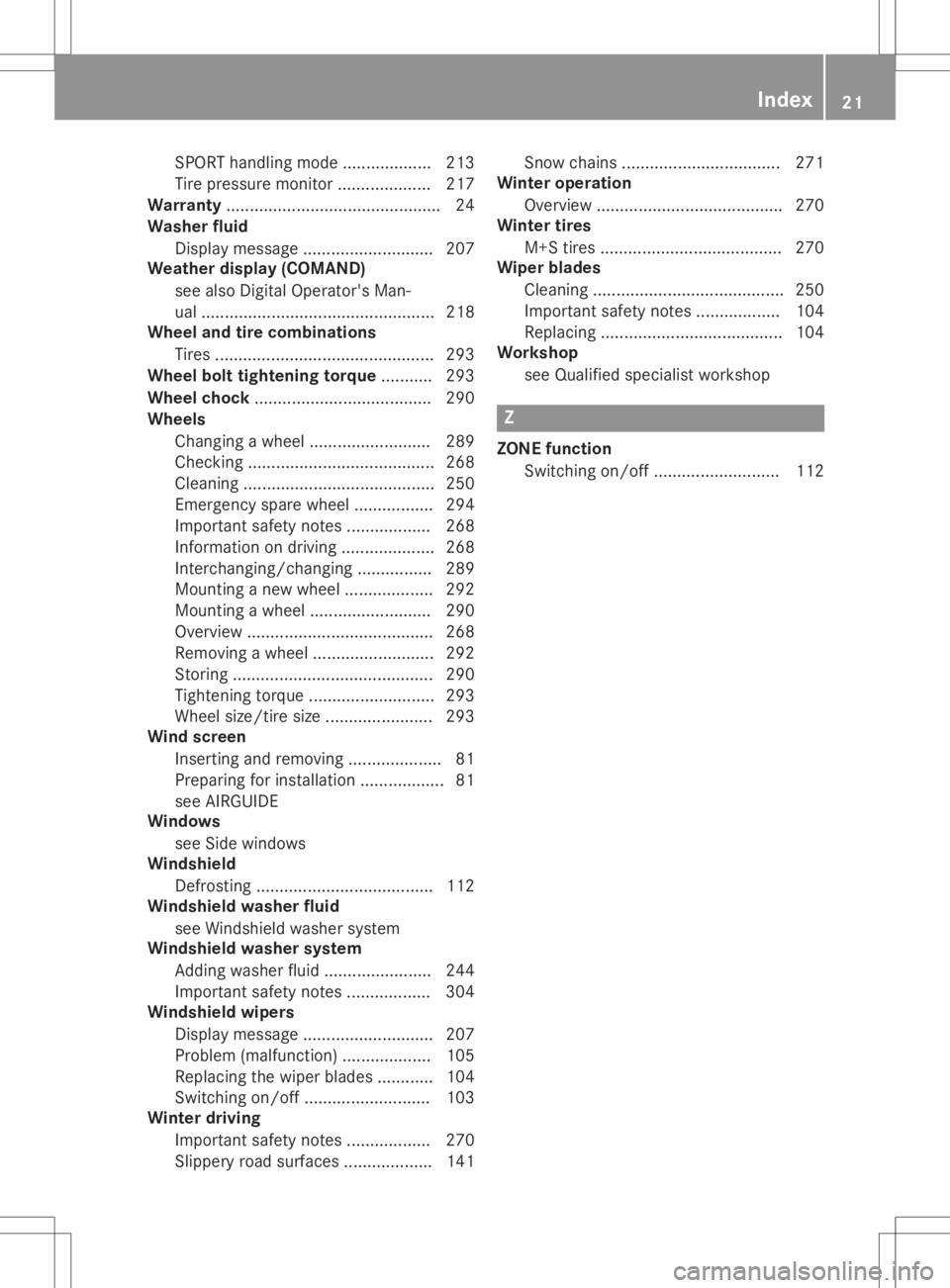
SPOR
Thandling mod e.<0011001100110011001100110011001100110011001100110011001100110011
00110011[ 213
Ti re pre ssu remoni tor<0011001100110011001100110011001100110011001100110011001100110011
0011001100110011[ 217
Warranty <0011001100110011001100110011001100110011001100110011001100110011
0011001100110011001100110011001100110011001100110011001100110011
00110011001100110011001100110011001100110011001100110011> 24
Washe rflui d
Disp laym essage <0011001100110011001100110011001100110011001100110011001100110011
001100110011001100110011001100110011001100110011[ 207
Wea ther display (COMA ND)
see also Digi talOpe rator'sMan-
ua l.<0011001100110011001100110011001100110011001100110011001100110011
0011001100110011001100110011001100110011001100110011001100110011
0011001100110011001100110011001100110011001100110011001100110011
0011[ 218
Whe eland tirecombin ations
Ti res <0011001100110011001100110011001100110011001100110011001100110011
0011001100110011001100110011001100110011001100110011001100110011
001100110011001100110011001100110011001100110011001100110011> 293
Whe elbo lttig hten ingt orque ........... 293
Whe elcho ck<0011001100110011001100110011001100110011001100110011001100110011
0011001100110011001100110011001100110011001100110011001100110011
001100110011001100110011> 290
Whe els
Ch ang ingawheel<0011001100110011001100110011001100110011001100110011001100110011
0011001100110011001100110011001100110011[ 289
Ch ecki ng<0011001100110011001100110011001100110011001100110011001100110011
0011001100110011001100110011001100110011001100110011001100110011
00110011001100110011001100110011> 268
Cl ea ning <0011001100110011001100110011001100110011001100110011001100110011
0011001100110011001100110011001100110011001100110011001100110011
001100110011001100110011001100110011> 250
Emerg encysparewh eel <0011001100110011001100110011001100110011001100110011001100110011
0011[ 294
Impo rtant safety notes <0011001100110011001100110011001100110011001100110011001100110011
00110011[ 268
Infor mationondriving <0011001100110011001100110011001100110011001100110011001100110011
0011001100110011[ 268
Interch anging/cha nging ................ 289
Mou nting anew wheel <0011001100110011001100110011001100110011001100110011001100110011
001100110011[ 292
Mou nting awheel<0011001100110011001100110011001100110011001100110011001100110011
0011001100110011001100110011001100110011[ 290
Ove rview <0011001100110011001100110011001100110011001100110011001100110011
0011001100110011001100110011001100110011001100110011001100110011
00110011001100110011001100110011> 268
Re movi ngaw heel<0011001100110011001100110011001100110011001100110011001100110011
0011001100110011001100110011001100110011[ 292
Stori ng<0011001100110011001100110011001100110011001100110011001100110011
0011001100110011001100110011001100110011001100110011001100110011
00110011001100110011001100110011001100110011> 290
Ti ghte ning torque<0011001100110011001100110011001100110011001100110011001100110011
00110011001100110011001100110011001100110011[ 293
Whe elsize /tire size<0011001100110011001100110011001100110011001100110011001100110011
0011001100110011001100110011[ 293
Win dscree n
Inse rting andremo ving<0011001100110011001100110011001100110011001100110011001100110011
0011001100110011[ 81
Pre paring forinsta llati on <0011001100110011001100110011001100110011001100110011001100110011
00110011[ 81
see AIRG UIDE
Win dow s
see Sidew indow s
Win dshi eld
Defro sting<0011001100110011001100110011001100110011001100110011001100110011
0011001100110011001100110011001100110011001100110011001100110011
001100110011001100110011> 112
Win dshi eldw asher fluid
see Windsh ield wa she rsystem
Win dshi eldw asher system
Addi ngwashe rfluid <0011001100110011001100110011001100110011001100110011001100110011
0011001100110011001100110011[ 244
Impo rtant safety notes <0011001100110011001100110011001100110011001100110011001100110011
00110011[ 304
Win dshi eldw ipers
Disp laym essage <0011001100110011001100110011001100110011001100110011001100110011
001100110011001100110011001100110011001100110011[ 207
Pro blem (ma lfunction) <0011001100110011001100110011001100110011001100110011001100110011
001100110011[ 105
Re placi ng the wipe rb lade s............ 104
Swi tching on/off.<0011001100110011001100110011001100110011001100110011001100110011
0011001100110011001100110011001100110011[ 103
Win terdrivi ng
Imp orta ntsafety notes <0011001100110011001100110011001100110011001100110011001100110011
00110011[ 270
Sli pp ery roadsurfaces <0011001100110011001100110011001100110011001100110011001100110011
001100110011[ 141Snow
chains<0011001100110011001100110011001100110011001100110011001100110011
0011001100110011001100110011001100110011001100110011001100110011
00110011> 271
Win terope ratio n
Ove rview <0011001100110011001100110011001100110011001100110011001100110011
0011001100110011001100110011001100110011001100110011001100110011
00110011001100110011001100110011> 270
Win tertire s
M+S tires.<0011001100110011001100110011001100110011001100110011001100110011
0011001100110011001100110011001100110011001100110011001100110011
001100110011001100110011> 270
Wipe rblades
Cl ea ning <0011001100110011001100110011001100110011001100110011001100110011
0011001100110011001100110011001100110011001100110011001100110011
001100110011001100110011001100110011> 250
Imp orta ntsafety notes <0011001100110011001100110011001100110011001100110011001100110011
00110011[ 104
Re placi ng <0011001100110011001100110011001100110011001100110011001100110011
0011001100110011001100110011001100110011001100110011001100110011
0011001100110011001100110011> 104
Work shop
see Qualifie ds pecia list wo rksho p Z
ZONE function
Swi tching on/off.<0011001100110011001100110011001100110011001100110011001100110011
0011001100110011001100110011001100110011[ 112 In
dex
21
Page 35 of 310
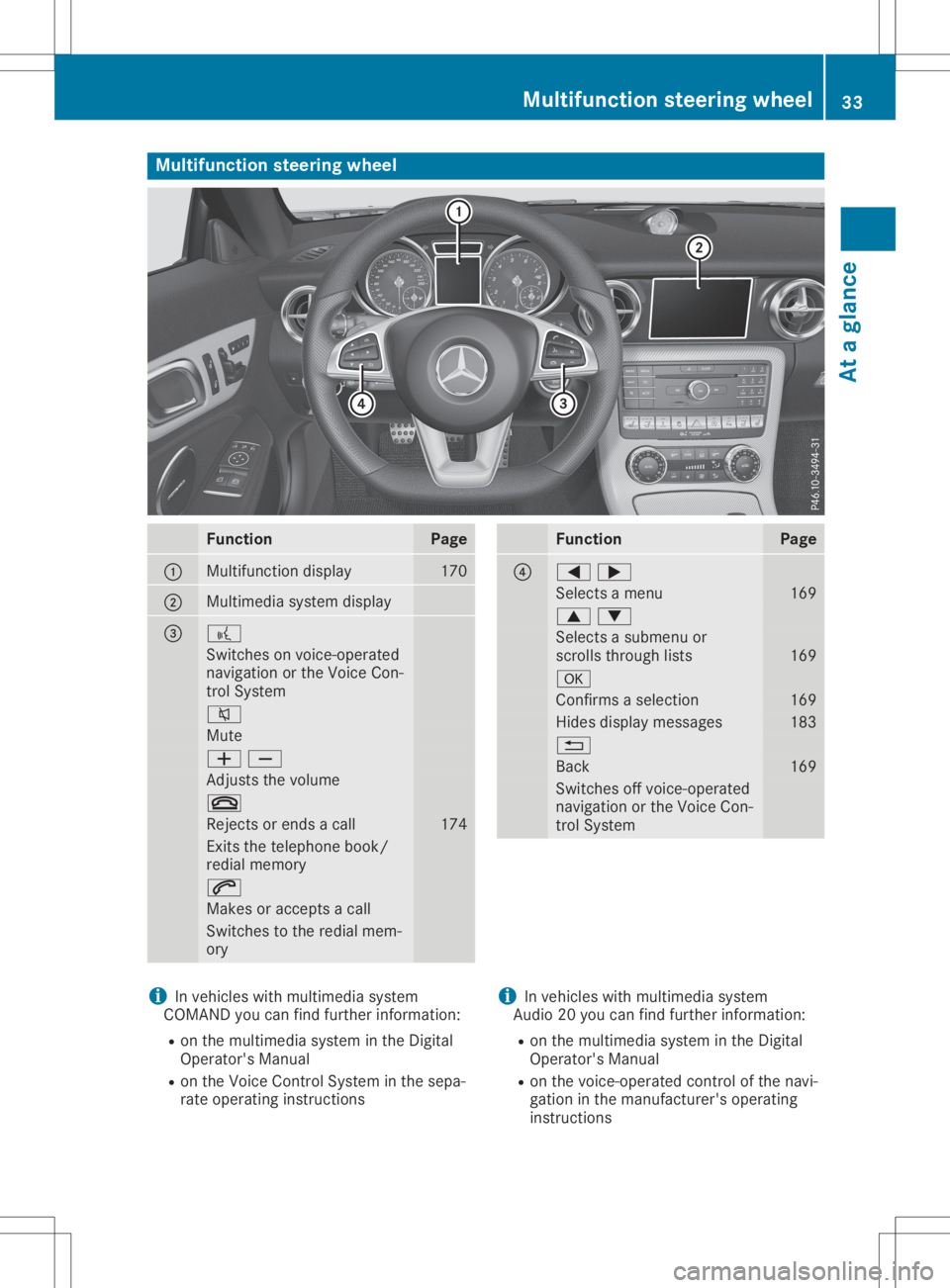
Multifunc
tionsteering wheel Func
tion Page
0043
Mul
tifunction display 170
0044
Mul
timedi asystem display 0087 0059
Switches
onvoice-op erated
naviga tionorthe Voice Con-
trol System 0063
Mute
00810082
Adju
ststhe volum e 0076
Re
jects orend sac all 174
Exits
thetelephone book/
red ialm em ory 0061
Ma
kes oracce ptsacall Swi
tche stot he red ialm em -
ory Fun
ction Pag
e 0085
00590065
Sel
ects amenu 169
00630064
Sel
ects asubme nuor
scrol lsthrou ghlists 169
0076
Co
nfirm saselectio n 169
Hid
esdispl aymes sages 183
0038
Back 169
Swi
tches offvoice-op erated
navi gation orthe VoiceCon-
trol System i
Inveh icles with mul time dias ystem
CO MAND youc an find further informa tion:
R on the multime dias ystem inthe Digi tal
Ope rator'sManua l
R on the VoiceControl System inthe sepa-
rate operatinginstru ctions i
Inveh icles with mul time dias ystem
Aud io20 youc an find further informa tion:
R on the multime dias ystem inthe Digi tal
Ope rator'sManua l
R on the voice-op erated control ofthe navi -
ga tion inthe manu facturer'soperati ng
instru ctions Multi
functions teeri ng wheel
33Atag lanc e
Page 48 of 310
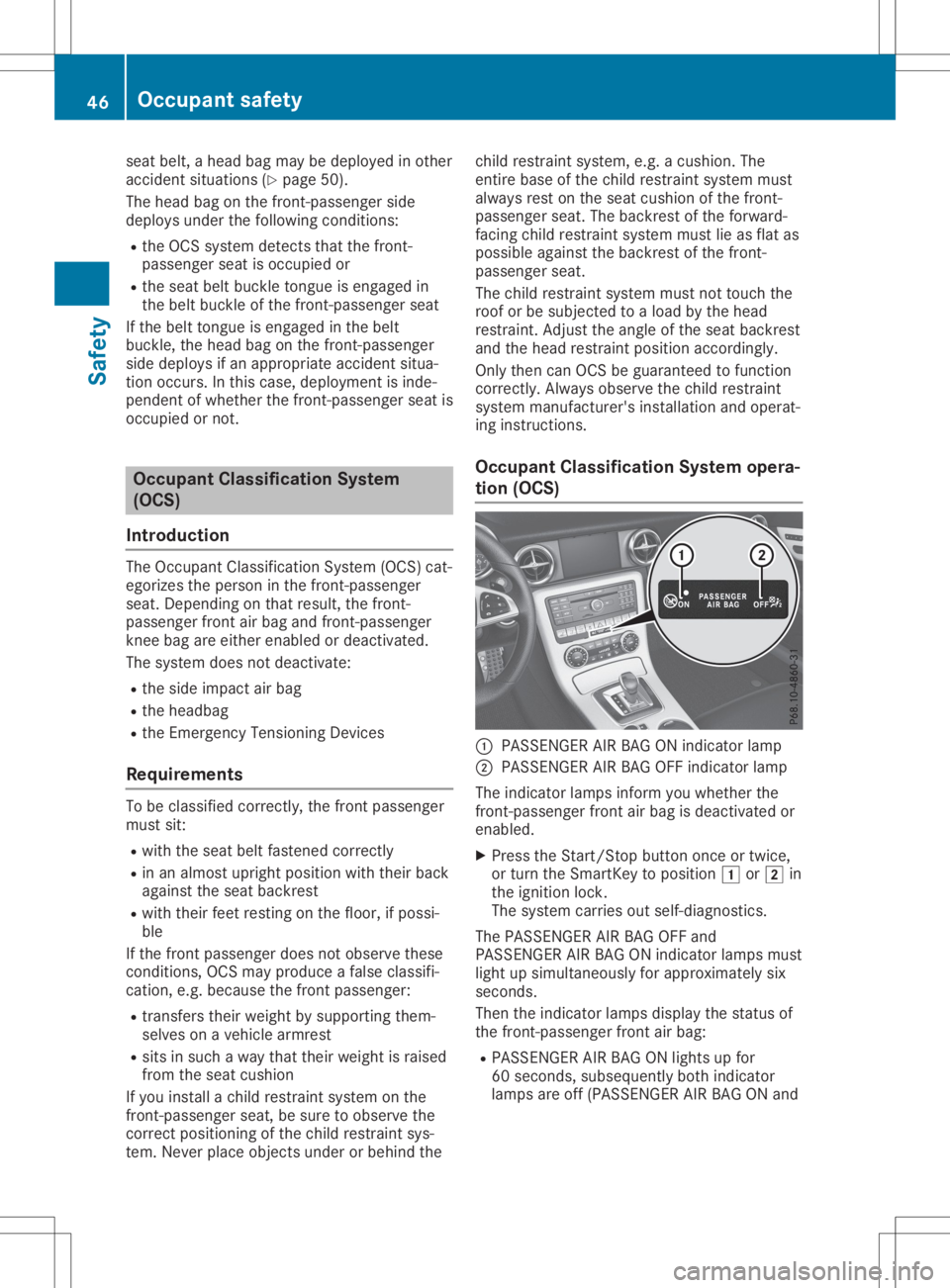
seat
belt, ahead bagmay bedeploy edinother
accident situations (Ypage 50).
The head bagonthe front -passenger side
deploy sunder thefollowi ngconditions:
R the OCS system detects thatthefront -
passenger seatisoccupied or
R the seat beltbuckle tongue isengaged in
the belt buckle ofthe front -passenger seat
If the belt tongue isengaged inthe belt
buckle, thehead bagonthe front -passenger
side deploy sifa na ppropria teaccident situa-
tion occurs. Inthis case, deploy mentisinde-
pendent ofwhether thefront -passenger seatis
occupied ornot. Occupant
ClassificationSystem
(OCS)
Introduction The
Occupant Classification System(OCS)cat-
egorizes theperson inthe front -passenger
seat. Depending onthat result, thefront -
passenger frontairbag and front -passenger
knee bagareeither enabled ordeactivated.
The system doesnotdeactivate:
R the side impact airbag
R the headba g
R the Emergenc yTensioning Devices
Requirements To
be classified correctly,the front passenger
must sit:
R with theseat beltfastened correctly
R in an almost upright position withtheir back
agai nstthe seat backrest
R with their feetresting onthe floor, ifpossi-
ble
If the front passenger doesnotobserve these
conditions, OCSmayproduce afalse classifi-
cation, e.g.because thefront passenger:
R transfers theirweight bysupporting them-
selves onavehicle armrest
R sits insuch awaythat their weight israised
from theseat cushion
If you install achild restraint systemonthe
front -passenger seat,besure toobserve the
correct positioning ofthe child restraint sys-
tem. Never placeobjects underorbehind the child
restraint system,e.g.acushion. The
entire baseofthe child restraint systemmust
alwa ysrest onthe seat cushion ofthe front -
passenger seat.Thebackrest ofthe forward-
facing childrestraint systemmustlieasflat as
possible againstthe backrest ofthe front -
passenger seat.
The child restraint systemmustnottouch the
roof orbe subjected toaload bythe head
restraint. Adjusttheangle ofthe seat backrest
and thehead restraint positionaccordingly.
Only thencanOCS beguara nteed tofunction
correct ly.Always observe thechild restraint
system manufacturer's installationandoperat-
ing instruct ions.
Occupant ClassificationSystem opera-
tion (OCS) 0043
PASSE NGERAIRBAG ONindicator lamp
0044 PASSE NGERAIRBAG OFFindicator lamp
The indicator lampsinform youwhether the
front -passenger frontairbag isdeactivated or
enabled.
X Press theStart/ Stopbutton onceortwice,
or turn theSmartKey toposition 0047or0048 in
the ignition lock.
The system carriesout<00560048004F004900100047004C0044004A0051005200560057004C00460056
0011[
The PASSE NGERAIRBAG OFFand
PASSE NGERAIRBAG ONindicator lampsmust
light upsimultaneousl yfor approximately six
seconds.
Then theindicator lampsdisplaythe status of
the front -passenger frontairbag:
R PASSE NGERAIRBAG ONlights upfor
60 seconds, subsequentlybothindicator
lamps areoff(PASSE NGERAIRBAG ONand 46
Occ
upant safetySafety
Page 51 of 310
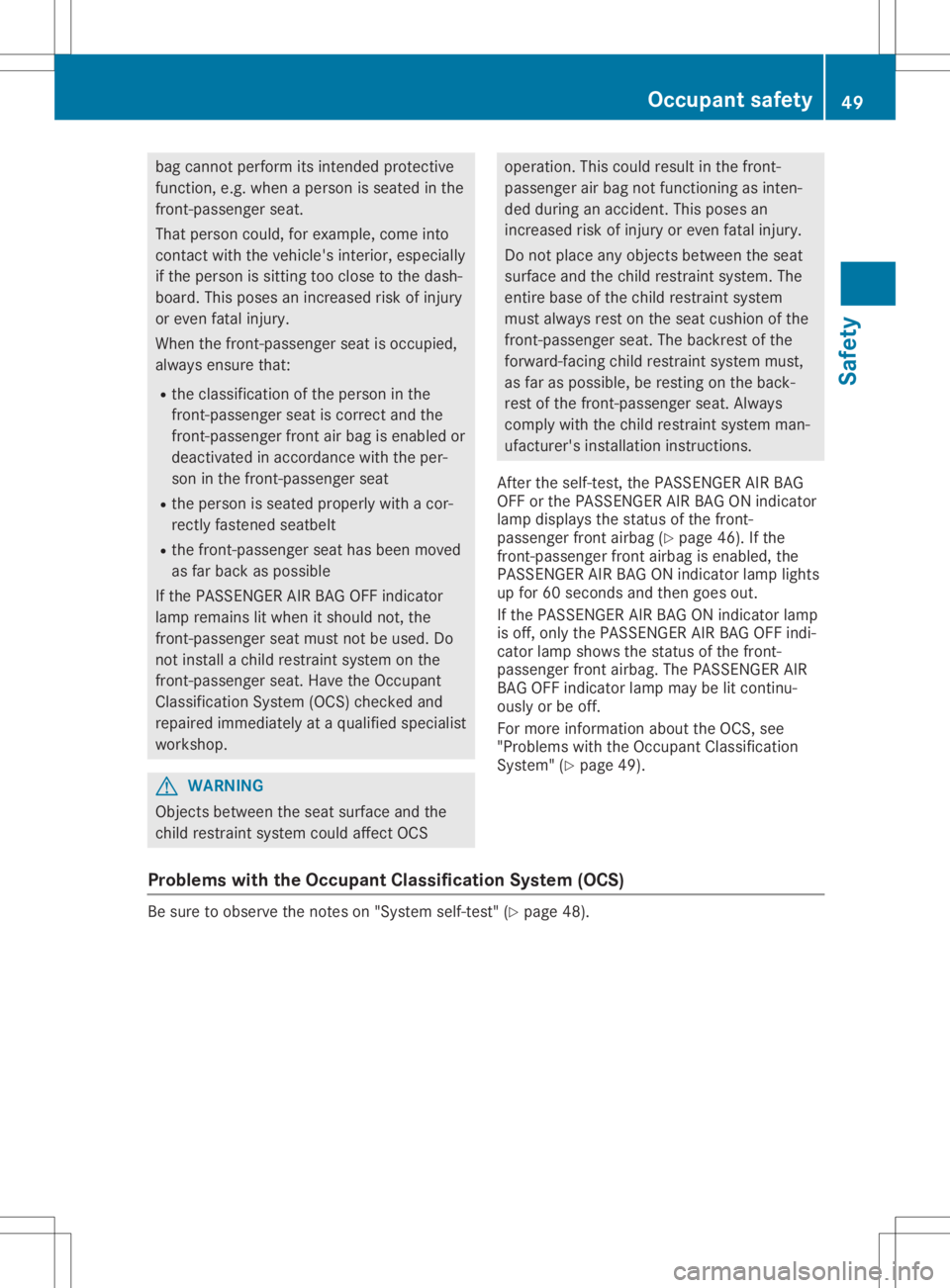
bag
cann otperfor mitsint ended protective
func tion,e.g. when aperson isseated inthe
fron t-passenger seat.
That person could,forexample, comeinto
con tact with thevehicle's interior, especially
if the person issitt ing too close tothe dash-
board. Thisposes anincr eased riskofinjury
or even fatalinjury.
When thefron t-passenger seatisocc upied,
always ensure that:
R the classific ationofthe person inthe
fron t-passenger seatiscorr ectand the
fron t-passenger frontairbag isenabled or
deactiv atedinaccor dance withtheper-
son inthe fron t-passenger seat
R the person isseated properly withacor-
rect lyfasten edseatbelt
R the fron t-passenger seathasbeen moved
as far back aspossible
If the PAS SENGER AIRBAGO FFindicat or
lamp remains litwhen itshould not,the
fron t-passenger seatmust notbeused. Do
not installac hild restraint system onthe
fron t-passenger seat.Have theOcc upant
Classification System(OCS)checkedand
repaired immediately ataq ualified specialist
worksh op. G
WARN
ING
Objec tsbetween theseat surface andthe
child restraint system couldaffect OCS operation
.This could result inthe fron t-
passenger airbag notfunc tioningasinten-
ded during anacciden t.This poses an
incr eased riskofinjury oreven fatalinjury.
Do not place anyobjec tsbetween theseat
surface andthechild restraint system. The
ent irebase ofthe child restraint system
must always restonthe seat cushion ofthe
fron t-passenger seat.Thebackr estofthe
forward- facingchild restraint system must,
as far aspossible, berest ingonthe back-
rest ofthe fron t-passenger seat.Always
comply withthechild restraint system man-
ufactur er'sinstallation instruct ions.
Aft erthe self-t est,thePAS SENGER AIRBAG
OFF orthe PAS SENGER AIRBAGO Nindicat or
lamp displays thestatusofthe fron t-
passenger frontairbag (Ypage 46).Ifthe
fron t-passenger frontairbag isenabled, the
PAS SENGER AIRBAGO Nindicat orlamp lights
up for 60secon dsand then goes out.
If the PAS SENGER AIRBAGO Nindicat orlamp
is off, only thePAS SENGER AIRBAGO FFindi-
cator lampshows thestatusofthe fron t-
passenger frontairbag. ThePASSENGER AIR
BA GO FFindicat orlamp maybelitcon tinu-
ously orbe off.
For more information abouttheOCS, see
"Problems withtheOcc upant Classification
System "(Ypage 49).
Problems withtheOccupant Classification System(OCS) Be
sure toobserve thenoteson "System self-test"(Ypage 48). Occupant
safety
49Safet y Z
Page 61 of 310
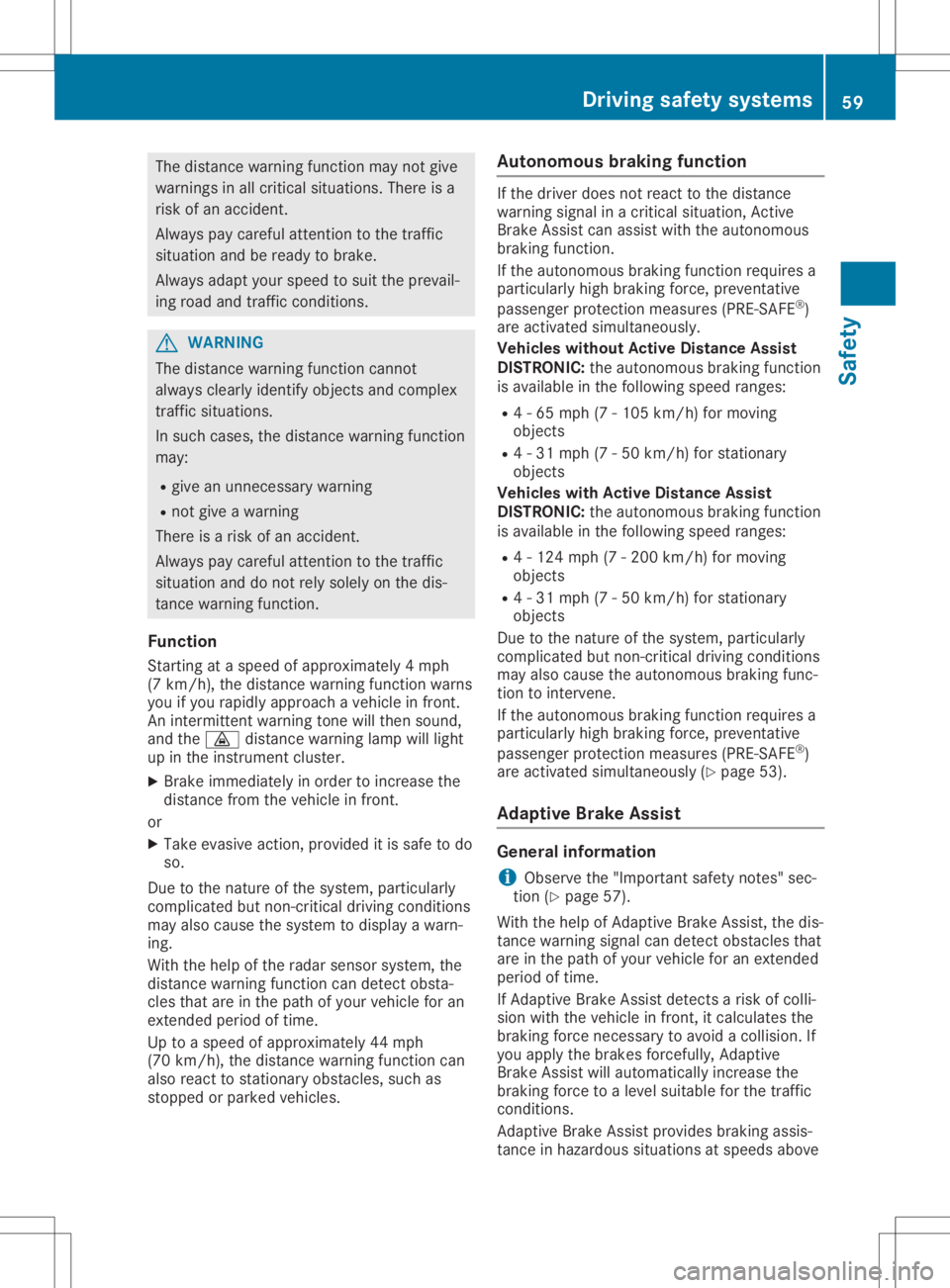
The
distance warningfunctionmay notgive
warnings inall critic alsituations. Thereisa
risk ofan accident .
Always paycareful attentiontothe traff ic
situation andbeready tobrake.
Always adaptyourspeed tosuit theprevail-
ing road andtrafficcondit ions. G
WARNIN
G
The distance warningfunctioncann ot
alway sclearly identify objectsand complex
traff icsituations.
In such cases, thedistance warningfunction
may:
R give anunnec essary warning
R not give awarning
There isar isk ofan accident .
Always paycareful attentiontothe traff ic
situation anddonot rely solely onthe dis-
tanc ewarning function.
Function Start ingatas peed ofapproximately 4mph
(7 km/ h),the distance warningfunctionwarns
you ifyou rapidly approach avehicle infront .
An inter mittentwarning tonew illthen sound,
and the00BA distance warninglampwilllight
up inthe instr ument cluster.
X Brake immediately inorder toincrease the
distance fromthevehicle infront .
or X Take evasive action,provided itis safe todo
so.
Due tothe nature ofthe system, particularly
complicated butnon- critic aldriving conditions
may alsocause thesystem todisplay awarn-
ing.
With thehelp ofthe radar sensor system, the
distance warningfunctioncan detect obsta-
cles thatareinthe path ofyour vehicle foran
exten dedperiod oftime.
Up toas peed ofapproximately 44mph
(70 km/ h),the distance warningfunctioncan
also react tostation aryobstacles, suchas
stopped orparked vehicles. Autonomous
brakingfunction If
the driver doesnotreact tothe distance
warning signalinac ritic alsituation, Active
Brake Assist canassist withtheautonomous
braking function.
If the autonomous brakingfunctionrequires a
particularly highbraking force,prevent ative
passenger protectionmeasures (PRE-SAFE®
)
are activated simultaneously.
Vehicles withoutActiveDistance Assist
DISTRONIC: theautonomous brakingfunction
is availab lein the following speedranges:
R 4-6 5mph(7-105 km/ h)for moving
objects
R 4-3 1mph(7-50k m/h )for stationa ry
objects
Vehic leswith Active Distance Assist
DI STRONIC: theautonomous brakingfunction
is ava ilable inthe followi ngspee dranges :
R 4-1 24mph (7-200 km/h )for moving
objects
R 4-3 1mph(7-50k m/h )for stationa ry
objects
Due tothe nature ofthe system ,parti cula rly
compli catedbutnon-critical drivingconditio ns
may alsoc aus ethe autonomous brakingfunc-
tion tointervene.
If the autonomous brakingfunction requiresa
parti cularlyhigh braki ngforce, preventa tive
pas senger protection measures(PRE-SAFE ®
)
are activa tedsimu ltaneo usly(Ypag e53).
Adaptive BrakeAssist Gene
ralinfo rmation
i Observ
ethe "Imp ortant safetynotes" sec-
tion (Ypag e57).
With thehelp ofAdapti veBrake Assist, thedis-
tance warning signalcan detect obstaclesthat
are inthe path ofyou rvehicl efor an extended
peri odoftime.
If Adapti veBrake Assist detects arisk ofcolli -
sion with thevehicl einf ront, itcalcu latesthe
braki ngforce necessa ryto avoi dac ollision. If
you applythe brakes forcefully,A dapti ve
Brake Assist willautomatica llyincreas ethe
braki ngforce toaleve lsuitabl efor the traffic
conditio ns.
Adapti veBrake Assist providesbraki ngassi s-
tance inhaza rdoussitua tions atspee dsabo ve Driv
ingsafety systems
59Safety Z
Page 81 of 310

Only
have thesoft topclosed manuall yata
qual ified speciali stworkshop.
! Never
siton the rear shelf orstore heavy
objects there.Youwillotherwise damage
the roof andtherear shelf ofyour vehicle.
! Do
not forget thattheweather canchange
abruptly .Make certain thattheroof is
closed whenyouleave thevehicle. Thevehi-
cle electronics canbedamaged ifwater
enters thevehicle interior.
! When
opening andclosing theroof, make
sure that:
R there issufficient clearance, asthe roof
swings upwards.
R there issufficient clearance behindthe
vehicle, asthe trunk lidswings backwards
beyond thebumper.
R the trunk isonly loade dtob elow the
trunk partition.
R the trunk partition isnot pushed upbythe
load.
R the trunk partition isclosed.
R the trunk lidisclosed.
R the outside temperature isabove 5‡
( 00F8 15 †).
You could otherwise damagetheroof, trunk
and other partsofthe vehicle.
The vehicle dimensions foropening/closing
the roof canbefound inthe "Vehicle data"
section (Ypage 305).
Make surethattheroof andrear window are
clean anddrybefore opening theroof. Other-
wise, water ordirt could enterthevehicle inte-
rior ortrunk. Opening
andclosing using theroof
switch
Importa ntsafety notes G
WARNING
When opening orclosing theroof, body
parts could betrapped by,forexample, the
roof mechanism, trunklidorside windows.
There isar isk ofinjury.
When raising orlowering theroof, make
sure thatnobody parts areinthe vicinity of moving
component s.Ifsomeone becomes
trapped, releasethebutton.
For safety reasons, youcan only open orclose
the roof when thevehicle isstationary.
! Operating
theroof while pulling awa y:
R Observe thefollowi ngtraffic carefully .
R Do not drive faster than25mph
(40 km/h).
R Avoid abrupt braking andswerving
maneuvers.
Do not operate theroof when cornering,
driving onuneven surfaces orduring strong
winds. Thevehicle mayotherwise bedam-
aged.
i If
the traffic conditions meanthatyouhave
to drive offwhile opening/closing theroof,
the procedure whichwasstarted whilesta-
tionary canbecont inued atspeeds ofup to
approximately 25mph (40km/h).
Opening andclosing X
Vehicles
withoutsemi-automa tictrunk
part ition: closethetrunk partition
(Y page 80).
X Close thetrunk lid(Ypage 73).
X Turn theSmartKey toposition 0048inthe igni-
tion lock.
X Open thecover inthe lower center console.
Roof switch 0043islocated underthecover.
X To open:p ullroof switch 0043until theentire
roof isstowed awayint he trunk.
The Vario-Roof inOperation Vario-Roof
inOperation message
appea rsinthe multifunction display.Once
the opening procedure iscomplete, the
message disappearsandatone sounds.
All ofthe side windows open. Roof
79Opening andclosing Z
Page 82 of 310

If
you opera tethe roof switch andthe
Trunk Partition Open Trunk
Partition Openmessage appears
in the multifu nctiondisplay,the trunk parti-
tion isnot closed correctly.
X Clos ethe trunk partition.
X To clo se: press andhold soft-top switch0043
until thesoft topisfull yclosed.
The Vario-Roof inOperation Vario-Roof
inOperation message
appe arsinthe multifu nctiondisplay.Once
the opening procedureiscomplete, the
messag edisappea rsand atone sounds.
All ofthe side window sopen.
X To close allside window s,pul lthe switch
under thecover ofthe center console
(Y page 76). Openin
g/closing using theSmart Key
Important safetynotes G
WARNING
When opening orclosing theroof, body
parts could betrapped by,forexample ,the
roof mechanism, trunklidorside window s.
There isar isk ofinjury.
When raisingorlowe ringtheroof, make
sure thatnobody parts areinthe vicinity of
moving components. Ifsomeone becomes
trapped ,relea sethe button.
Openin gand closing This
function isonly availableon vehicle swith
KEYLESS- GOorwith roofcomfort operation.
X Clos ethe trunk lid(Ypage 73).
X Vehicl eswith comfort operation: point
the tipofthe SmartKey atthe driver's door
handle .
X Vehicl eswith KEYLESS -GO:theSmartKey
must bewithin 6ft(2m )ofthe vehicle .
X To open: pressandhold the0036 button on
the SmartKey untiltheroof isfull yopened.
The roof andtherear side window sopen.
The front sidewindow sclose.
X To
interrupt theopeni ngprocedure:
relea sethe 0036 button.
X To open thefront sidewindows: pressthe
0036 button onthe SmartKey again. X
To clo se: press andhold the0037 button
on the SmartKey untiltheroof isfull y
closed.
The roof andtheside window sclose.
X To
interrupt theclosing procedure:
relea sethe 0037 button. Loc
king theroof again
Important safetynotes G
WARNING
If you donot fullyopen/close thesoft top,
the soft-top hydraulics depres surizeaftera
short time.Thiscause sthe soft toptolowe r
unexpectedly andmay cause youorothers
to be trapped .There isar isk ofinjury.
Alway sopen orclose thesoft topcom-
pletel y.
The roof isnot locked if:
R the 0059 symbo land the Vario-Roof in Vario-Roof
in
Operation Operation
messageappe arinthe multi-
function display
R the 0059 symbo land the Open/Close Open/Close
Vario-Roof Completely Vario-Roof
Completelymessageappe ar
in the multifu nctiondisplayand youhear a
warning tone
R you hear awarning toneforuptoten sec-
onds when pulling awayorw hiled riving
Loc king You
canlock theroof againifit is not locked
full y.
X Pul lover and stop thevehicle safelyassoon
as possib le,pay ing attention toroad and
traffic conditions.
X Ensure thattheSmartKey isin positio n0048
in the ignition lock.
X Press theroof switch (Ypage 79). Trunk
partition
Gene ralnotes !
To
avoid damagingtheroof orlug gage
when foldingback theroof, youshoul d: 80
RoofOpeni
ngand closi ng
Page 102 of 310

The
corn ering lampmayremain litfor ashort
time, butisautomatically switchedoffafter no
more thanthree minutes.
Cornering lightfunction withtraffic circle
function:
The corn ering lightfunct ionisactivated on
both sides before enteringatraff iccircle
through anevaluation ofthe current GPSposi-
tion ofthe vehicle. Itremains activeuntilafter
the vehicle hasleftthetraff iccircle. Inthis
way, pedestrians crossingthe road, forexam-
ple, areilluminated byyour vehicle ingood
time. Active
lightfunction
The active lightfunct ionisas ystem that
moves theheadlamps accordingtot he steer-
ing movemen tsof the front wheels. Inthis
way, relevant areasremain illuminated while
driving. Thisallows youtorecogn izepedes-
trians, cyclists andanimals sooner.
Active: whenthelights areswitched on.
Vehicles withLane Keeping Assist:the active
light funct ionevaluates thecourse ofthe lane
in which youaredriving andpre-empt ively
cont rolstheactive lightfunct ion. Adapt
iveHighbeam Assist
General notes You
canusethis funct iontoset the headlamps
to change between lowbeam andhigh beam
automatically. Thesystem recognizesvehicles
with their lights on,either approaching from
the opposite direction ortraveling infront of
your vehicle, andconsequent lyswitches the
headlamps fromhighbeam tolow beam.
The system automatically adaptsthelow-beam
headlamp rangedepending onthe distance to
the other vehicle. Oncethesystem nolonger
detect sany other vehicles, itreactivat esthe
high-beam headlamps.
The system's opticalsensorislocated behind
the windshield neartheoverhead control
panel. Import
antsafety notes G
WARNIN
G
Adaptive Highbeam Assistdoesnotrecog-
nize road users:
R who have nolights, e.g.pedestrians
R who have poorlighting, e.g.cyclists
R whose lighting isblocked, e.g.byab arrier
On very rareoccasions ,Adaptive Highbeam
Assist mayfailtorecogn izeother roadusers
that have lights, ormay recogn izethem too
late. Inthis, orinsimilar situations, theauto-
matic high-beam headlamps willnotbe
deactivated orwill beactivated regardless.
There isar isk ofan accident .
Always carefully observethetraff iccondi-
tions andswitch offthe high-beam head-
lamps ingood time.
Adaptive Highbeam Assistcannottake into
account road,weather ortraff iccondit ions.
Adaptive Highbeam Assistisonly anaid. You
are responsible foradjusting thevehicle's
lighting tothe prevailing light,visibility and
traff iccondit ions.
In particular, thedetect ionofobstacles canbe
restr icted ifthere is:
R poor visibility, e.g.due tofog, heavy rainor
snow
R dirt onthe sensors orthe sensors are
obscured
Switching AdaptiveHighbeam Assist
on/off X
To switch on:turn thelight switch to0058.
X Press thecombinat ionswitch beyond the
pressure pointinthe direction ofarrow 0043.
The 00CE indicator lampinthe multifunct ion
display lightsupwhen itis dark andthelight
sensor activates thelow-beam headlamps.
If you aredriving atspeeds aboveapprox-
imately 16mph (25km/ h):
The headlamp rangeisset automatically
depending onthe distance between the
vehicle andother roadusers.
If you aredriving atspeeds aboveapprox-
imately 19mph (30km/ h)and noother
road users havebeen detect ed: 100
Exterior
lightingLightsandwindshield wipers